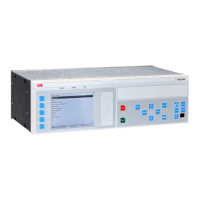Voltage polarizing
When voltage polarizing is selected the protection will use either the residual voltage 3V
0
or the negative sequence voltage V
2
as polarizing quantity V3P.
The residual voltage can be:
1. directly measured (when a dedicated VT input of the IED is connected in PCM600 to
the fourth analog input of the pre-processing block connected to EF4PTOC (51N/
67N) function input V3P). This dedicated IED VT input shall be then connected to
open delta winding of a three phase main VT.
2. calculated from three phase voltage input within the IED (when the fourth analog
input into the pre-processing block connected to EF4PTOC (51N/67N) analog
function input V3P is NOT connected to a dedicated VT input of the IED in
PCM600). In such case the pre-processing block will calculate 3V
0
from the first
three inputs into the pre-processing block by using the following formula:
ANSIEQUATION2407 V1 EN (Equation 9)
where:
VA, VB, VC are fundamental frequency phasors of three individual phase voltages.
In order to use this, all three phase-to-ground voltages must be connected to three IED VT
inputs.
The residual voltage is pre-processed by a discrete fourier filter. Thus, the phasor of the
fundamental frequency component of the residual voltage is derived.
The negative sequence voltage is calculated from the three-phase voltage input within the
IED by using the pre-processing block. The preprocessing block will calculate the
negative sequence voltage from the three inputs into the pre-processing block by using the
following formula:
( )/3VPol VA alpha VB alpha VC= + × + ×
GUID-F09A69D7-A8A6-4354-B0B8-F4EC7BBE603F V2 EN (Equation 10)
where:
VA, VB, VC are fundamental frequency phasors of three individual phase voltages.
alpha unit phasor with an angle of 120 degrees.
1MRK 511 287-UUS A Section 6
Current protection
105
Technical manual

